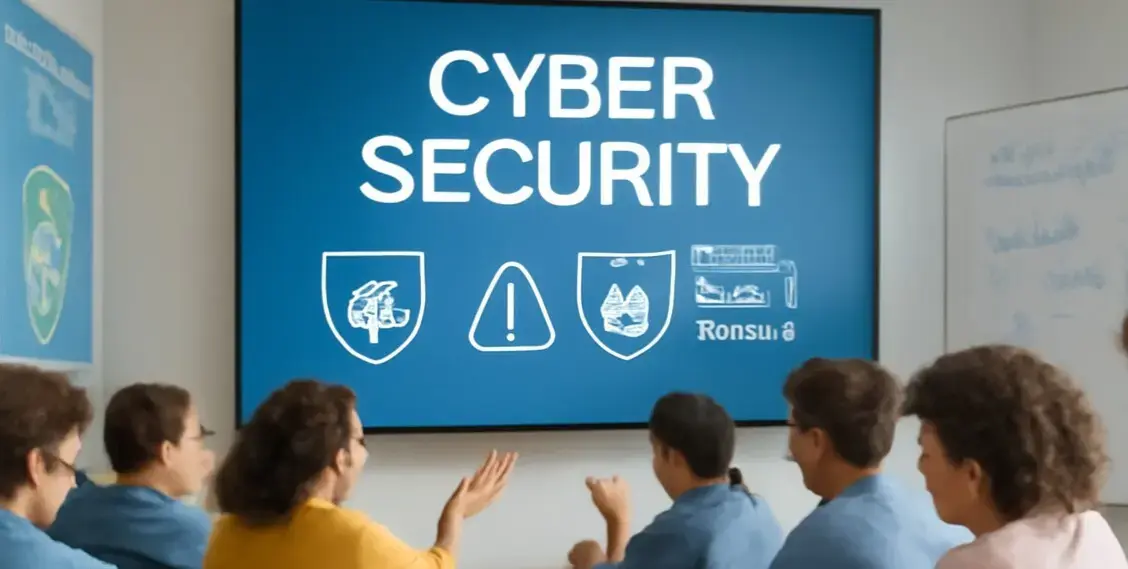Top Cyber Security Tabletop Exercise Examples & Scenarios
Date: 15 April 2025

Cyber Tabletop Exercises are critical today for future-focussed, cyber resilient businesses. With the massive spike in cyber attacks and ransomware attacks, businesses need to improve their cybersecurity incident response plans. But more importantly, you need to test these plans repeatedly in a cyber incident simulation to ensure they hold water.
In this blog, we cover different cyber tabletop exercise cybersecurity examples that you can start running within your organisation. They will enable you to protect yourself from the real life cyber threats that are looming large.
Top Cyber Security Tabletop Exercise Examples
1. Malware Attack
2. Phishing Attack
3. Ransomware Attack
4. Supply Chain Attack
5. Cloud Service Outage
Don't forget to download our most comprehensive document - The top 30 cyber tabletop exercise scenarios. Created by top cyber drill experts, this document also lists the key assets to protect first and the common threats to be aware of.
Before we start, let's quickly understand what Cyber Tabletop Exercises are, their goals, and why they are important.
What is a Cyber Security Tabletop Exercise?
During Incident Response Tabletop Exercises, an organisation typically hires an experienced external cybersecurity consultant. This external expert usually has years of expertise in handling, managing and mitigating the impact of cyber crises and data breaches.
This facilitator works with the relevant teams and key stakeholders in your organisation. They create a cyber crisis simulation which is most pertinent to your business and operational model. The scenario will focus on an attack on your most critical assets to identify gaps in your protection strategy.
The facilitator will create an environment of panic. But the idea is not to scare anyone - it’s simply to force everyone to think how they would act and react when such a complex cybersecurity incident does occur. .jpg?width=300&height=200&name=186521217_m%20(1).jpg)
Information security tabletop drills effectively prompt discussions on team roles and responsibilities during incidents.
You can also gauge how information sharing takes place in your organisation during the exercise - is it quick enough? Is it accurate? Is it effective enough to control the impact of the attack in real time?
A cyber security tabletop exercise is an effective hands-on training for cyber incident response. The facilitator is an experienced outsider. So they will be able to offer an objective third-party perspective on how equipped your organisation and the staff is to handle a real crisis. They can also identify weaknesses in your incident response plans that your team might miss.
Cyber Drills are a cost-effective way to put your incident response plans through a litmus test. The exercise will reveal whether the plans are as good in reality as they sound on paper. They will also show you if the steps in the incident response plan are actually actionable or not. All of this happens in a safe environment.
In fact, the best part about cyber tabletop exercises is that they create minimal to no interruption to your daily business. In fact, they don’t actually impact the operations or the cybersecurity infrastructure in any way.
Download our Cyber Crisis Tabletop Exercise Checklist to prepare for the workshop in advance and make the most out of it for your business and security team. You'll also want to check out our Data Breach Tabletop Exercise Template which is easy to use and customise to your organisational context.
Now that we understand how Cyber Tabletop Exercises enhance your business's cyber incident response, let's explore some scenario examples.
Top Cyber Tabletop Exercise Scenarios and Examples
Here are some common cyber attack tabletop exercise scenario examples that you must absolutely be prepared for.
The scenarios may sound quite straightforward at first glance. A skilled exercise facilitator can turn these scenarios into complex and specific challenges. This will test how detail-oriented, agile, and capable your key decision-makers are.
1. Malware Attack
One of the most common types of attacks that occurs these days is a malware attack. The hacker actually finds in-roads into your business through simple loopholes. These could be a leaked password or an employee downloading a malicious attachment without realising.
In this cyber attack tabletop exercise example, participants are cajoled into evaluating how such an attack could take place at all. Then they’re forced to think what they will do to deal with a malware that blocks everybody’s access to the system computers, for example.

This exercise will start discussions on how to handle the employee who made the mistake and how to train others to avoid similar errors in the future. Stakeholders will need to consider how to stop the malware attack and keep the business running if it happens.
A malware attack may sound like a rudimentary scenario. With the help of an experienced cybersecurity expert, it can really uncover many hidden cybersecurity issues for your business.
2. Phishing Attack
Phishing attacks remain one of the most common and effective entry points for cybercriminals. This makes them a critical scenario to rehearse during a cyber tabletop exercise.
Simulating a phishing incident helps organisations test their ability to detect suspicious emails. It shows the team how to escalate incidents appropriately and contain potential breaches before they escalate. It also evaluates how well employees understand reporting protocols. This cyber tabletop exercise example is ideal for judging if the incident response team can coordinate swiftly across departments.
3. Ransomware Attack
A ransomware attack also starts like a malware attack. However, it usually takes on different and more complicated proportions pretty quickly.
In a ransomware attack, hackers block access to your data or threaten to leak it unless a ransom is paid. (These days, the ransom is usually demanded in cryptocurrency).
A ransomware tabletop exercise focuses special attention on questions that arise during this specific kind of attack.
Will you pay the ransom? Will you negotiate with the hacker? Do you have adequate backups in place that render the hackers' threats meaningless to you?
Who will take these critical decisions? Who will communicate with the malicious actors, if at all?
A ransomware tabletop exercise really tests the mettle of your incident response teams and puts pressure on everyone to think about what the best response strategies could be.
You can also download our Ransomware Checklist and Ransomware Response Checklist before the tabletop exercise for added preparation. Participants can also be handed our visual Ransomware Response Workflow. They can refer to it during the exercise to make better and sounder decisions.
4. Supply Chain Attack
Your business, like most others, probably uses the services of third-party vendors, suppliers, and cloud platforms etc.
Since you have a lot of data, you likely use multiple service providers. And if one gets hacked, it can cause problems. What do you do?
This is an important cyber attack tabletop exercise example to work with. In this case, it’s not your employees that have made a mistake. It’s not even about how protected your environment was and if you’d taken adequate backups etc. The responsibility for these issues was on a third-party vendor. But because of a breach in their system, your business is in trouble.
To grasp the severity of such an attack, consider the SolarWinds supply chain incident.
This example usually really forces businesses to think outside their comfort zone. It may even lead to some alterations or amendments in the disaster recovery plans.
5. Cloud Service Compromise
A cloud compromise is technically part of a supply chain compromise. However, it is essential to practice this high-risk scenario on its own. Every organisation leveraging cloud infrastructure must rehearse this scenario through cyber tabletop exercises.
With the growing reliance on SaaS platforms and cloud-based storage, a breach or misconfiguration in cloud services can lead to massive data exposure. Simulating this scenario helps test incident detection capabilities. You can also test the incident response team's coordination with cloud providers.
By rehearsing this scenario, you can greatly minimise operational disruptions in case of a cloud outage. You will also be better prepared for data recovery and compliance obligations in case of a real world compromise.
How to prepare for a Cyber Tabletop Exercise?
Most businesses begin their preparation for a Cyber Tabletop Exercise by getting their cybersecurity artefacts (plans, procedures, policies and processes) in order. Essentially, the tabletop exercise is a test of all of these.
Some businesses need help in either creating new cybersecurity documents or reviewing and refreshing their existing ones. Due to the cyber skills shortage and high costs of hiring specialists, many small to medium businesses struggle to start.
This is where the unique & cost-effective cybersecurity services by Cyber Management Alliance can be a game changer. Our Virtual Cyber Assistant and Virtual Cyber Consultant services give you access to expert cybersecurity consultants who can help you conduct effective cyber tabletop exercises. They can facilitate cybersecurity assessments and enhance your incident response and ransomware strategies.
They can also facilitate effective cyber drills for your business that are relevant to your specific industry and business size. The consultant can also help you work on the Executive Summary report you receive at the end of the workshop. They can help you work on the gaps in your cybersecurity infrastructure. They also help you offer the right kind of training to any employees who may require it.
Final Word
Cyber security tabletop exercises are no longer a luxury—they're an essential part of building cyber resilience. As cyber threats grow more complex and frequent, incident response plans must be tested and refined through realistic tabletop exercise scenarios.
From ransomware tabletop exercises to supply chain attack simulations, each example shared in this article demonstrates how structured, role-specific drills can uncover hidden gaps and improve your team’s coordination under pressure. Whether you're part of an IT department, executive leadership, or an incident response team, these exercises are invaluable for strengthening your overall information security posture.
Start small or go big—but start now. Incorporating regular cyber security tabletop drills into your risk management strategy is one of the smartest moves any business can make in today’s threat landscape.







.webp)
.webp)
.webp)
